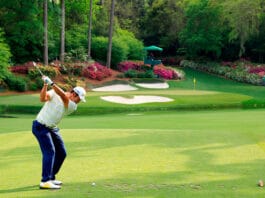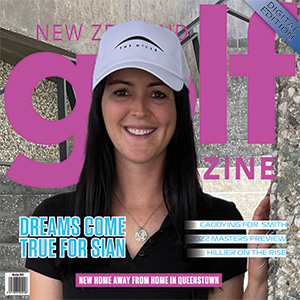From growing up in Northland and Auckland, being educated on the Gold Coast, then travelling the world, working in some magical environments, through to enjoying life on the water in the Bay of Islands, Kristine Kerr is not your typical golf architect! However, she has definitely earned her credentials and is internationally recognised for her skills.
When I spoke to Kristine, she was relaxed and happy to chat about her various projects that she was involved with; as many are projects for private clients, no names were mentioned, but let’s just say she is keeping busy in Kerikeri. She has to be the best ambassador for the area, as she raves about enjoying the beach, getting out on her paddle board, surfing or simply gardening. Kerikeri is also a great place for good wines and fine dining, so life is pretty good in the north. “As an ‘earthquake refugee’ from Christchurch, I chose the best place that fit the lifestyle I wanted to live and Kerikeri has really worked for me. Plus, here I have found a lot of demand for my services”.
Start talking golf courses with Kristine and you’ll find that she has a very relaxed, natural approach to design. “The golf course needs to look like it has been part of nature and I guess that is why I am a fan of links golf courses. A golf course like Shinnecock Hills, that hosted this year’s US Open, is really something special. One of my favourite courses in New Zealand is Kauri Cliffs. The setting is absolutely perfect but it’s the way the course flows over the contours that makes the place really special. Also, it’s about how the different natural features are incorporated into the course”.
“When I first see a site, I really like to spend time getting to see the land and contours from all angles. Where will the first tee be and what is the perfect site for the 18th green? What is happening in the environment, what is the type of vegetation, what is the wind direction and where does the sun come from at different times of the day? Some aspects of the land will just stand out and others you just have to shape into the surrounds. You need to walk the site to really get the feel for how the course may play”. According to Kristine “this is when you see the key natural features that you will want to incorporate or areas that standout as being perfect for tees or greens; so the rest of the design just follows from there. Visualisation of what the finished product may look like is exciting for me. Some golf course architects like to manufacturer a golf course, where I far prefer to shape what is there to get the style and form that will get the best outcome for everyone, especially the client and the golfers that will play the course”.
For many years of her life, Kristine travelled with no real fixed abode. It was one golf course project after another. “My parents moved us from Auckland to the Gold Coast when I was ten as they were involved in the development of Palm Meadows. I went to the Queensland University of Technology (QUT) in Brisbane and graduated with a Landscape Architecture/Urban and Regional Planning degree. By the time I graduated, my parents were living in Singapore, so after my OE in Europe I headed there and soon landed a job with a leading golf architecture firm, Nelson Wright Haworth. Golf course construction in Asia was booming at the time, and it was an extremely busy number of years for me. When I see tournaments like the Malaysian Open being played at Kuala Golf and Country Club, it takes me back to those early days when we were shaping and contouring the land”.
“One of my favourite projects during this time was the Shan-Shui Golf and Country Club. It is located on an island off the east coast of Malaysia; we wove the course through a palm plantation and river valley, and used the undulations of the local mountains. The course is now home to some incredible wildlife including many exotic birds, the local monkeys and a resident crocodile. The course still consistently rates as one of the top courses in Asia”!
From Singapore, Kristine moved to London where she was soon working for Gary Player Design. “Mr Player had recently secured projects in Italy (the 9-hole Palazzo Arzaga Course, Lake Garda) and in the Czech Republic (the Cihelny Golf Course, near Prague). Then there was the site visit in the private jet to the Cascades at Soma Bay, on the western edges of the Red Sea in Egypt. These were big budget projects in amazing locations, where we were able to create breathtaking, world class golf courses. I learned a lot from Mr Player with his ethos of letting ‘the best all-round player win’, which has carried across to my own design philosophy. A course shouldn’t just suit the longest driver, the best iron player or the purest putter, but the best all-round player should be the champion. When I was at QUT, I don’t think I could have imagined that I would end up building golf courses with such legends of the game, in such exotic locations”.
After another stint in China with Gary Player, Kristine took on a lead role with construction and upon completion, decided to look for a role back home in the Pacific. In a case of “being in the right place at the right time”, she joined Boffa Miskell to undertake the design of Pegasus. With her planning and landscaping experience, coupled with her many years of experience in golf course architecture, this was the perfect first “solo project” for her.
“Pegasus will always be a delight to me being the first course that was truly ‘my’ project, and because its always so well received. I worked with a great team, and the management crew and staff have done a spectacular job in keeping the quality alive. I was a little nervous that the site was so flat, with few features to work with. However, there were some natural waterways and the site was of both historical and cultural significance to the local iwi, with elements that defined some areas of the design, such as the split fairway on Hole 15 – a real talking point. New lakes were a major feature that gave us fill material to shape the course, creating landforms that blend to the foothills of the Southern Alps beyond. Despite the client’s brief outlining the goal of a residential/member’s course, most of my experience had been in championship course design. This must have shown through as Pegasus hosted the New Zealand Women’s Golf Open in February 2010 when the course was literally two months old. And now, to have it host the New Zealand PGA (New Zealand’s second biggest men’s professional event) is going to be wonderful”!
The words she repeatedly used when we discussed Pegasus were “classic” and “strategic”. The key features of the course that she highlighted were: the fairways are undulating with movement, and there are different slopes in the fairways which can be receptive and welcoming if you hit them in the right area. “The greens are receptive when coming in from the right part of the fairway and they flow naturally on from the fairway. The front nine is more open and plays a little easier, whereas the back nine weaves around corners of the property, where some great natural features come into play. Yes, there are some hazards but they are more about creating illusion, rather than directly impacting the hole or the golfers shot making ability”.
However, as the members and frequent golfers at Pegasus will attest, the course will stand up to the talented players, regardless. The course actually caters to all levels of golfers and can often be a harder test for the better players if they haven’t played from the right tees or if they try to overpower the course. Kristine expects the rough will be grown in a little more and some of the fairways slimmed down, thus placing more emphasis on accuracy off the tee.
When I asked her what type of player would the course best suit, she was quick to tell me “the one that best understands the layout and was patient”. She continued to say that if they “try to muscle the driver, they will end up in places where the angles won’t be right and the pins won’t be accessible. Trouble will be brought into play and it will be easier to make bogey than birdie! Whereas, if the golfer throttles back a little, there are places in the fairway where everything is accessible and birdies will be easy. Most of the members will tell you this is a course that teaches you patience and you take the opportunities when they present. You don’t go and attack the course! Conditions will also be a factor and if the wind gets up, the course could be very challenging”.
Today, the majority of Kristine’s work with her company Kura Golf Course Design, involves remodelling existing golf courses or golf holes. Currently, she is working with the Omaha Beach Golf Club to remodel the north nine holes. At the Pakuranga Golf Club she is redesigning the 10th Hole from a Par 4 to a Par 3 after the club sold off some land for development. The redesign of the Par 4, 11thHole at the Waitangi Golf Club was another favourite job. Pushing the green back, making it a long and challenging Par 5, with the green nestling on the Pacific Ocean, followed by a cliff-top, great risk-reward, short Par 4, 12th Hole.
The earthquakes in Christchurch had quite an effect on Kristine but lead to one of the projects she is most proud of, which is still in progress. Waimairi Beach Golf Club was shattered by the earthquakes and subsequent liquefaction, leading to the opportunity to re-route and revamp the whole course. The sandy soils were perfect for reshaping holes and incorporating the dunes into the hole terrain, and removal of old pines completely revamped the course. Previous liquefaction areas have become integral waste areas, creating a new character to the course. “We have completed 16 holes and eventually, all 18 holes will be redesigned. It was tremendously rewarding to be creating that for the members and it’s fabulous to see the golf club being a lively hub and an active part of the community in this part of the city”.
It is easy to see why Kristine was recognised as the first female member of the Australian Society of Golf Course Architects. This honour has allowed her to grow her business; today 85% of her projects are in New Zealand and 15% overseas. One of these international projects that is really exciting her is a major redesign project done in conjunction with China’s former Number One professional golfer at a golf course in Macau. “This is a great golf property that is going to be pretty special by the time we are finished with it. They really want it to be one of the top resort and championship courses in the region and there is a sizeable budget to make it happen”.
At the same time, Kristine is really passionate about her subdivision and landscape work. “I love working with the land and helping to create different environments and themes. Particularly large scale residential work, thinking about how clients who are building their dream homes and landscapes that will mature and bring enjoyment to the owners, motivates me. I have been fortunate that I truly think all my clients have been great and largely word of mouth has continued to keep me busy”.
“Spending more time at home has also allowed me to get more involved in the New Zealand golf industry and I am very excited about being a part of the relatively newly formed NZ Golf Industry Council. I’m enjoying working with the many talented people that form the board and who are active across all sectors of the golf industry. We all have the same goals in growing the golf economy, having government and local government appreciate the role golf plays and contributes to our communities and ensuring that golf is fun. With my planning knowledge and expertise, we could talk for another hour or more on how the Auckland City Council could fix many of their issues. And about how golf could play a successful role in assisting the city to become an even greater place to live. Golf courses and other important green spaces act as lungs for the city, so it is hugely important to treat them as the assets they are, highlight their accessibility and integrate them into communities”.
Kristine is really excited to see the NZPGA Championship return to Christchurch and is thrilled to see the event being played at Pegasus. “I know the ladies loved playing Pegasus and the feedback from them was great. I am looking forward to seeing how the men attack the course and naturally hope they enjoy it as much! And yes, I also look forward to seeing who wins and their score”. As does NZGM.





